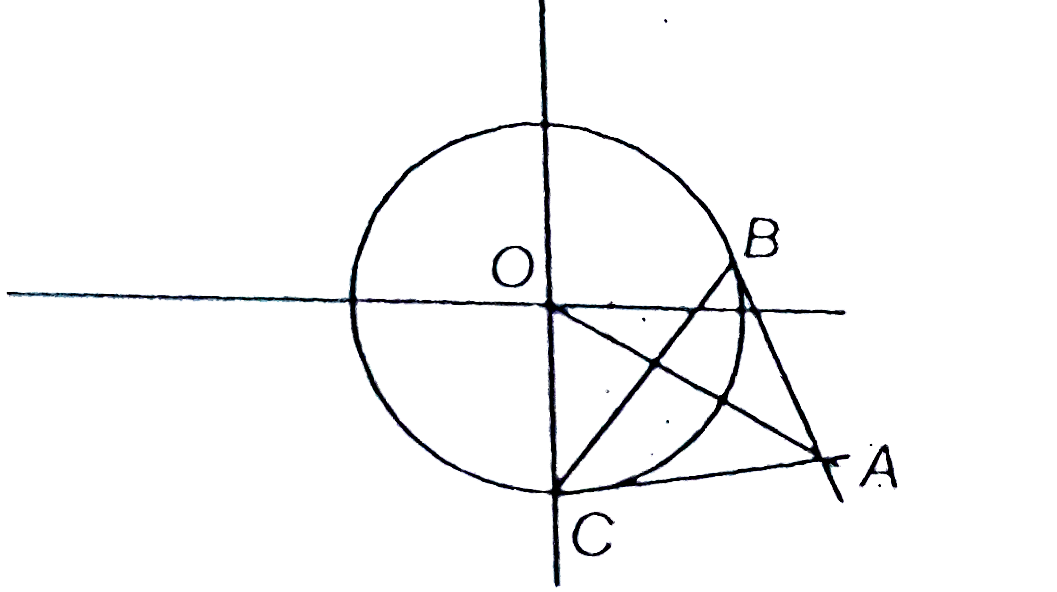Statement 1 : If the chords of contact of tangents from three points A,B and C to the circle x2+y2=a2 are concurrent, then A,B and C will be collinear. Statement 2 : Lines (a1x+b1y+c1)+k(a2x+b2y+c2)=0 alwasy pass through a fixed point for k∈R .
To solve the problem, we will analyze both statements one by one.
Statement 1:
Statement: If the chords of contact of tangents from three points A,B, and C to the circle x2+y2=a2 are concurrent, then A,B, and C will be collinear.
Solution:
1. Chord of Contact: The chord of contact from a point (x1,y1) to the circle x2+y2=a2 is given by the equation:
xx1+yy1=a2
This can be rearranged to:
xx1+yy1−a2=0
2. Chords from Points A, B, and C: Let the coordinates of points A,B, and C be (x1,y1),(x2,y2), and (x3,y3) respectively. The equations of the chords of contact for these points are:
- For point A: xx1+yy1−a2=0
- For point B: xx2+yy2−a2=0
- For point C: xx3+yy3−a2=0
3. Concurrent Condition: The chords are concurrent if the determinant of the coefficients of x and y from these equations is zero. Thus, we set up the determinant:
∣∣
∣
∣∣x1y1−a2x2y2−a2x3y3−a2∣∣
∣
∣∣=0
4. Simplifying the Determinant: Factoring out −a2 from the third column gives:
−a2∣∣
∣∣x1y11x2y21x3y31∣∣
∣∣=0
This implies:
∣∣
∣∣x1y11x2y21x3y31∣∣
∣∣=0
5. Conclusion: The determinant being zero indicates that the points A,B, and C are collinear. Therefore, Statement 1 is correct.
Statement 2:
Statement: Lines (a1x+b1y+c1)+k(a2x+b2y+c2)=0 always pass through a fixed point for k∈R.
Solution:
1. Equation of Lines: The given equation can be rewritten as:
(a1+ka2)x+(b1+kb2)y+(c1+kc2)=0
2. Fixed Point: We need to find the fixed point where this line passes for all values of k. This line will pass through a fixed point if there exists a solution to:
a1x+b1y+c1=0anda2x+b2y+c2=0
These are two lines, and their intersection (if it exists) will be the fixed point.
3. Conclusion: Since the lines represented by a1x+b1y+c1=0 and a2x+b2y+c2=0 can intersect at a single point (assuming they are not parallel), the combined line will always pass through this intersection point for all k. Therefore, Statement 2 is also correct.
Final Conclusion:
Both Statement 1 and Statement 2 are correct.
---
Statement: If the chords of contact of tangents from three points A,B, and C to the circle x2+y2=a2 are concurrent, then A,B, and C will be collinear.
1. Chord of Contact: The chord of contact from a point (x1,y1) to the circle x2+y2=a2 is given by the equation:
xx1+yy1=a2
This can be rearranged to:
xx1+yy1−a2=0
- For point A: xx1+yy1−a2=0
- For point B: xx2+yy2−a2=0
- For point C: xx3+yy3−a2=0
∣∣
∣
∣∣x1y1−a2x2y2−a2x3y3−a2∣∣
∣
∣∣=0
−a2∣∣
∣∣x1y11x2y21x3y31∣∣
∣∣=0
This implies:
∣∣
∣∣x1y11x2y21x3y31∣∣
∣∣=0
Statement: Lines (a1x+b1y+c1)+k(a2x+b2y+c2)=0 always pass through a fixed point for k∈R.
1. Equation of Lines: The given equation can be rewritten as:
(a1+ka2)x+(b1+kb2)y+(c1+kc2)=0
a1x+b1y+c1=0anda2x+b2y+c2=0
These are two lines, and their intersection (if it exists) will be the fixed point.
Both Statement 1 and Statement 2 are correct.
Topper's Solved these Questions
- COMPLEX NUMBERS AND QUADRATIC EQUATIONSBOOK - CENGAGE ENGLISHCHAPTER - COMPLEX NUMBERS AND QUADRATIC EQUATIONSEXERCISE - All Questions
886 Videos
- DIFFERENT PRODUCTS OF VECTORS AND THEIR GEOMETRICAL APPLICATIONS BOOK - CENGAGE ENGLISHCHAPTER - DIFFERENT PRODUCTS OF VECTORS AND THEIR GEOMETRICAL APPLICATIONS EXERCISE - Multiple correct answers type
11 Videos
Similar Questions
The chords of contact of tangents from three points A,BandC to the circle x2+y2=a2 are concurrent. Then A,BandC will be
View SolutionThe chord of contact of tangents from 3 points A, B, C to the circle x2+y2=4 are concurrent, then the points A, B and C are:
View SolutionStatement I The chord of contact of tangent from three points A, B and C to the circle x2+y2=a2 are concurrent, then A, B and C will be collinear. Statement II A, B and C always lie on the normal to the circle x2+y2=a2.
View SolutionThe chords of contact of tangents from three points A,BandC to the circle x2+y2=a2 are concurrent. Then A,BandC will (a)be concyclic (b) be collinear (c)form the vertices of a triangle (d)none of these
View SolutionLet the midpoint of the chord of contact of tangents drawn from A to the circle x2+y2=4 be M(1,−1) and the points of contact be B and C

View SolutionIf the chord of contact of tangents from a point (x1,y1) to the circle x2+y2=a2 touches the circle (x−a)2+y2=a2, then the locus of (x1,y1) is
View SolutionIf the chord of contact of the tangents from the point (α,β) to the circle x2+y2=r21 is a tangent to the circle (x−a)2+(y−b)2=r22, then
View SolutionIf the chord of contact of the tangents drawn from a point on the circle x2+y2=a2 to the circle x2+y2=b2 touches the circle x2+y2=c2 , then prove that a,b and c are in GP.
View SolutionThe chords of contact of the pair of tangents drawn from each point on the line 2x+y=4 to the circle x2+y2=1 pass through the point (h,k) then 4(h+k) is
View SolutionThe chord of contact of the pair of tangents drawn from any point on 3x+4y=8 to the circle x2+y2=4 passes through a fixed point. (A) (12,158) (B) (2,32) (C) (32,2) (D) none of these
View Solution
